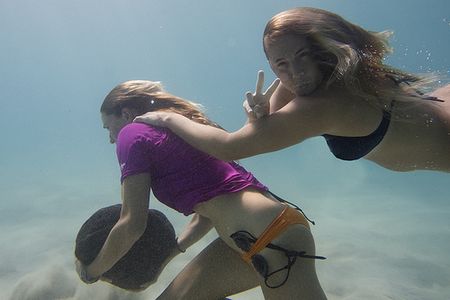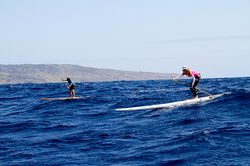
We set off on our journey on April 7, starting with a paddle across the Alenuihaha channel, which separates the Big Island and Maui. Having delayed our departure due to gale force winds earlier in the week, we were not sure what to expect of the notorious channel. It has been described as one of the most dangerous in the world–Alenuihaha means “great billows smashing”–not a friendly place for boats and even less so for 14-feet paddleboards. It didn’t help our confidence when search results for the channel mostly focused on survival stories. It didn’t stop us from trying, though. We had a goal and we were going to make it happen.
When the forecast showed a break in the weather, we made our move. We knew we had a small window and didn鈥檛 want to miss our chance to go. We left early in the morning from Keokea Park on Big Island and aimed for Hana, Maui. The conditions were unbelievable–we could not have asked for a better day to cross. The winds were light and the seas calm. Thirty minutes into our paddle, a juvenile humpback whale approached us. It swam directly beneath our boards and right up to the escort boat before swimmingaway. It was an amazing start to our paddle.

Besides these physical rough spots, there are also logistical issues to face daily. Setting up the escort boats, rental cars, places to stay, and movingour gear from place to place has been tough. It has been the most stressful part of our trip by far. There are days when instead of being outside in the water, we are stuck inside trying to prepare for our next crossing. It can be frustrating, but it is part of the adventure.
Despite having paddled more 100 miles, we feel physically great. We were sore after the first channel, but it only lasted a few days. Emotionally and mentally we are doing great as well. At times, the stress of moving around so often gets to us, but for the most part we have managed to stay surprisingly calm. The most difficult part is the mental aspect. The Alenuihaha channel between Big Island and Maui taught us how important it is to be mentally prepared for our crossings. Despite being physically able to cross the channel, it was a mental struggle that almost kept us from succeeding. In the end, though, we kept paddling and made it across.
We haven鈥檛 seen any trash piles in the ocean, but we have found plenty of pollutedbeaches. It seems that the most isolated beaches are the ones that are affected the most by plastics. We found a beach on the island of Lanai that was covered in debris–everything from toothbrushes to glue sticks and fishing line. It was sad to see such a beautiful beach ruined by such ugly waste.
But all in all, the trip is going really well so far. We have crossed five channels and paddled alongsome of the world鈥檚 tallest sea cliffs! On our more recent crossing, we had a pod of false killer whales join us–it was amazing. They seemed curious about the two of us out there in the middle of the channel on our stand-up paddleboards and playfully swam around and beneath us.
One thing we have learned is that no matter how much planning and preparing you do,things won鈥檛 turn out the way you think…and that鈥檚 not always a bad thing. We have had an amazing trip so far and look forward to what the next crossing and island will bring.
–Morgan Hoesterey and Jenny Kalmbach
launched , a expedition, from the Big Island of Hawaii on April 7, 2010. It’s an adventure that will take them through the Hawaiian islands, across three degrees of latitude, over 200 nautical miles, and acrossnine legendary open-ocean channels. Their goal is to raise awareness and funds for the ,which works to identify and understand the impact of plasticscontamination in our oceans and on marine life and the human food chain.
Photos: Top by Ryan Lopossa, bottom by Chris Aguilar